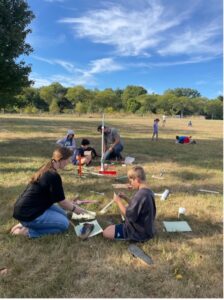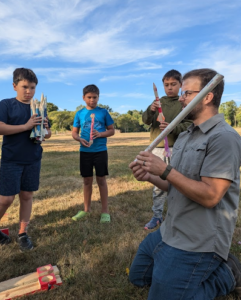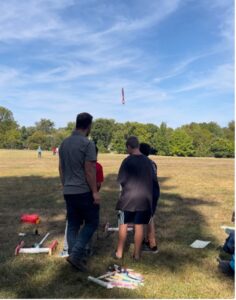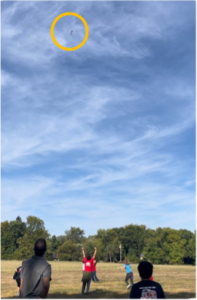At the Antioch School, where experiential learning is at the heart of the curriculum, I recently had the opportunity to bring an air-powered rocket launching experiment to the “Older Group” (OG) as part of their Arts & Sciences class. The school’s hands-on, student-driven approach to learning made this the perfect environment for an interactive lesson in prototyping, problem-solving, and persistence. Little did I know, this experience would turn into a live demonstration of what it means to work through the unexpected challenges of an evolving prototype.
Building the Launcher
The idea behind the lesson was simple: to spark curiosity about science and engineering by giving students the chance to design, build, and launch their own paper rockets using a pneumatic launcher. Leading up to the event, students learned about aerodynamic concepts like lift, weight, thrust, and drag, along with ideas about rocket stability. The launcher itself was a project I had built previously using PVC pipe, a sprinkler valve, and basic components from the hardware store. The design, inspired by a project on Instructables, had been lightly tested, and I felt confident it would work well for this class.
In preparation, I made some improvements to enhance the user experience. I added a “launch button” made from more PVC, a button, 9V batteries, and long wires, making it easier for the students to operate the launcher. However, in the process of adding these features, I had to deconstruct the previously working system. While I did test the system after rebuilding it, I only checked that the valve was making the correct “clicking” sound, assuming this meant the solenoid was activating and everything was functioning properly. The evening before the event, everything seemed to be working fine—or so I thought.
Launch Day: A Rocky Start
On the morning of the launch, the students arrived excited, ready to send their rockets into the sky. However, I quickly realized I had made an oversight when communicating with the teacher about the correct size of PVC for the launcher. Many of the rockets wouldn’t fit. We scrambled to make quick adjustments and build new rockets on the fly.

With a handful of properly sized rockets, we gathered around the launcher. The pressure built using a manual bike pump, and with high expectations, we hit the new and improved launch button. To everyone’s dismay—nothing happened. The rockets didn’t launch. At that moment, I lost more than half the class, as the students understandably moved on to other activities during their free time.

Prototyping Mindset in Action
Despite the initial failure, a few students remained, curious about what had gone wrong and eager to fix it. We got to work debugging the system. Much like any prototyping process, we took a logical approach: checking connections, swapping out components, and reverting to the last known working configuration. Slowly but surely, we worked through the issues, with much of the process being led by the students. You could see their minds at work as they analyzed and problem-solved.
Finally, after some persistence, we felt ready. We loaded a rocket, repressurized the launcher, hit the button, and watched as a rocket soared nearly 100 feet into the air! The excitement was palpable, and instantly, all the students who had drifted away came running back to join in the fun.

A Wild Success
What began as a potential failure turned into a wild success. The students started experimenting with different pressures, testing the impact of various launch angles, and tweaking their rocket designs to see who could achieve the highest or farthest launch. The lesson transformed into a dynamic session of prototyping and iteration, mirroring the trial-and-error process central to real-world engineering and design.

The Antioch School Approach
This project dovetailed perfectly with the Antioch School’s philosophy, albeit somewhat unintentionally. As an alternative, non-traditional educational institution, the school emphasizes hands-on, student-led learning. Their Arts & Sciences curriculum encourages experimentation, critical thinking, and the natural curiosity that comes from exploring open-ended questions. This experience was a testament to the school’s unique approach, where students aren’t simply given information, but are empowered to discover, test, and refine their ideas through active engagement.
Lessons in Curiosity and Persistence
In the end, the success of the rocket launch wasn’t just about getting a piece of paper to fly into the sky. It was about the process. The students’ willingness to stick with the project, ask questions, and experiment with solutions embodied the core principles of prototyping: persistence, creativity, and a desire to learn from failures. Without these qualities, the day could have ended in frustration. Instead, it became a highlight for everyone involved—students and teacher alike.
With positive feedback from the children, I sought out feedback from my other key stakeholder: the teachers. Elaina Vimmerstedt, the Arts & Science teacher, said, “I’m so grateful for this collaboration with the Older Group students. It was such a rich experience for them to have, especially because things didn’t go according to plan initially! The children got to apply concepts we’d been studying in class to a thrilling project, while also getting to practice the invaluable skills of problem-solving, iteration, and persistence. No perfectly-executed plan could have set up a better natural challenge for them to work through. It was so gratifying for them to solve the problems and ultimately see spectacular launches.”
As an engineering professional, it was a beautiful reminder of what I love about developing new solutions and designing new technology: stay curious, be persistent, and the hard work will pay off!
—
Joseph Althaus is Prototype Lead at Rushlight Ventures. He brings nearly 20 years of technology development and transition experience to the team. Joe’s career encompasses pivotal roles such as lead engineer, program manager, and team lead in defense and commercial sectors, managing complex projects and portfolios exceeding $10 million. An adept entrepreneur, he founded Smart Barn in 2012 and openhaus in 2016, and contributed to global brand launches. With 11 patents to his name, spanning various industries, Joe holds a B.S. in Electrical Engineering with a minor in mathematics and an M.S. in Electrical Engineering, specializing in controls engineering and embedded systems, both from Ohio University. His visionary approach is instrumental in driving the success of new technology and innovations.
Images approved for use by the Antioch School.
Contact us today to find out if Rushlight Ventures would be a good partner for your tech.
